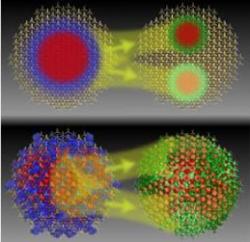A research team led by Mark Lusk at the Colorado School of Mines has discovered a way to enhance solar cell efficiency.
The research says the size of quantum dots that absorb light impacts its ability to transmit energy to electrons that will produce electricity. The report has been published in the forthcoming issue of the ACS Nano.
 Mines' MEG
Mines' MEG
The discovery corroborates the theory called multiple-exciton generation (MEG). MEG says an electron, called an exciton, with absorbed light energy, can transmit that energy to multiple electrons, causing the same amount of absorbed light to produce more electricity.
Quantum dots are atoms created by man that trap electrons in a nano-space. They behave like atoms causing nano-scale electronic characteristics. These characteristics could impact light interaction with matter. The team utilized a computer cluster supported by the National Science Foundation (NSF) to study the connection between the MEG and quantum dot size.
They discovered that every dot has a proportionate solar spectrum slice suitable for MEG function. Tinier dots perform MEG better than large dots. This means solar cells comprising quantum dots matching the solar spectrum will function better than cells comprised of material with no quantum dots. Lusk says that it will be possible to create nano-structured fabrics that produce multiple excitons from one light photon.
The team, which also had a group from the National Renewable Energy Laboratory, has been funded by the NSF as part of the Renewable Energy Materials Research Science and Engineering Center at the Colorado School of Mines situated in Golden, Colorado. The research is focusing on harnessing nano-structure properties to enhance solar panels’ efficiency.
Source: http://www.mines.edu/